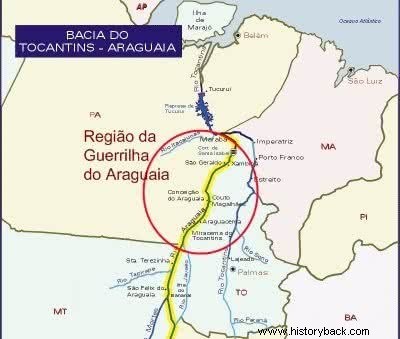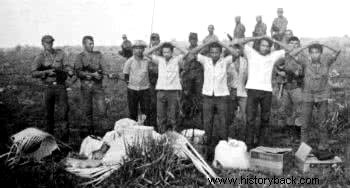The Guerrilha do Araguaia it was a fight between communist guerrillas and the Brazilian Armed Forces.
The fight took place in the north of the current state of Tocantins, between 1972 and 1974.
Historical Context
During the Medici Government (1969-1974), the Brazilian military dictatorship experienced the height of repression against its opponents. The forces of order made arrests and with the information obtained many times under torture, they dismantled leftist organizations that planned to end the military dictatorship.
In turn, communist groups advocated various ways of trying to overthrow the government. Some bet on urban actions with marches; and others kidnapped diplomats in the hope of drawing public attention to their cause.
Finally, there were those inspired by the Vietnamese resistance in the Vietnam War or by the action of Che Guevara, who looked to rural guerrillas as a way to end the military regime. The rural guerrilla focus tactic employed in China was also the model for these groups.
In this way, part of the PCdoB (Communist Party of Brazil) militants receive military training and penetrate the region known as “Bico do Papagaio”. The territory was located between the states of Goiás, Pará and Maranhão, on the banks of the Araguaia River.
Read more about Military Dictatorship in Brazil.

Guerrilha do Araguaia Map
Combat with the Army
As soon as they learned of the movement of communists in the area, the Brazilian Army was deployed to the region. At first they sent a contingent of inexperienced soldiers, but as the action spread, the commandos decided to send more prepared troops.
The local population also suffered from the guerrillas, as government forces used intimidation and torture to obtain information from residents.
There were three attacks by the government using men from the three Armed Forces and the Military Police, whose estimates range from 3,500 to 20,000 men. Recently, the Truth Commission claimed that the Army used napalm to fight the guerrillas.
For their part, the communists formed a group of 69 to 90 people between men and women who hoped to receive the support of the local population.
The Guerrilla is divided into three phases where the advances and setbacks of each involved party are noted.
First Combat
The Army began the attack, on April 12, 1972, attacking by surprise.
The recruits' little experience and the lack of rapport with the local population, however, meant that the first campaign was ended in July. The result, in military terms, was meager:four guerrillas killed and six arrested.
Second Combat
Between September and October 1972 there was more fighting. Despite the large military apparatus deployed to the region, the guerrillas - including the peasants who joined - remained active. The withdrawal of the military contingent was celebrated as a great victory by the communists.
Third Combat
The third campaign is what made the guerrillas known, among the military itself, as "dirty warfare" due to the disproportion of forces used to fight the guerrillas.
The Armed Forces changed tactics, using the "arapongas" (spies) of the Army Information Center (CIE).
They infiltrated agents into the city and obtained information from the population, sometimes using torture. At least 17 residents disappeared in two years of military campaign and hundreds were brutally interrogated.
The military opened operational roads, evacuated residents of the area – destroying their crops and homes on charges of being an accomplice of the guerrillas.
No chance against the well-trained and increasingly isolated soldiers, few guerrillas managed to escape. The final attack would be in October 1974, when Walkiria Afonso Costa, the last female guerrilla, was found. Taken to the city of Xambióa, she was murdered on the 25th of that month.

Inhabitants of Araguaia held by soldiers.
End of the Araguaia Guerrilla
On March 15, 1975, President Ernesto Geisel sent a short message to Congress stating that the Araguaia guerrilla bases were "completely reduced".
Some arrests were made, but several fighters on the guerrilla side died in ambushes, shot in the back. Importantly, there were no prisoners of war:the guerrillas simply ceased to exist.
With the defeat in Araguaia, the regime's opponents gave up the rural guerrilla path as a way of overthrowing the military regime. At this time, the opposition movement was increasingly disjointed due to arrests, exiles and assassinations committed by government forces.
61 fighters, of the 69 (or 90) who were in the jungle, never showed up again. According to the testimony of soldiers involved in Operation Cleanup, the bodies were taken to Serra das Andorinhas and incinerated.
Consequences of the Guerrilha do Araguaia
- By court order, in the 1990s, four expeditions searched for the bones of those who died during the fighting. Until 2010, only two bodies were found and recognized as guerrillas.
- On June 18, 2009, 44 peasants were granted political amnesty with financial compensation.
- Supported by the Amnesty Law, no military was tried for the crimes committed during the Guerrilha do Araguaia.
Films and documentaries
- Araguaya - The Conspiracy of Silence. Directed by:Ronaldo Duque. 2004.
- Paths of the Report:Guerrilha do Araguaia. Reporting:Emerson Pena and Paula Simas. Editing:Floriano Filho. 2010.
- Peasants of Araguaia - The Guerrilla seen from the inside. Directed by:Vandré Fernandes. 2010.
Don't stop here and read these texts related to the topic :
- Years of Lead
- Farc
- Operation Condor
- Serra Pelada
- Questions about the Military Dictatorship
